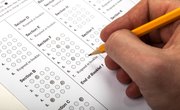For as long as you are a student, you should get comfortable with the idea of having to take standardized tests. Throughout your academic career, you will be faced with the requirement to take both achievement and aptitude tests. Therefore, it is important to understand the differences between achievement tests and aptitude tests.
At the elementary school level, tests are administered as benchmarks for promotion to the next grade. This pattern continues through middle school, and high school placement tests are administered in order to determine admission and class placement at the high school level. Additionally, tests are used to determine pass or fail of certain courses.
Beyond that, standardized tests are administered for additional reasons. In high school you can expect to take practice ACT or SAT tests, and then take the formal exam for entrance into college. From there, you may expect to take additional standardized tests in order to further your study at the graduate level.
Achievement vs. Aptitude Test: What Do They Measure?
How do you compare an achievement vs. aptitude test? Achievement measures what content a student has already learned or mastered, while aptitude measures a student's potential or ability to learn. Aptitude is more of a projection or forecast of a student’s potential or future ability. Achievement is more of a determination of how much a student has learned or mastered.
Achievement Tests
Achievement tests are designed to assess a test taker’s knowledge in certain academic areas. If you think about the word achievement, that is precisely what these kinds of tests measure. An achievement test will measure your achievement or mastery of content, skill or general academic knowledge.
Achievement tests can be both standardized and formal, but they can also be summative, non-standardized assessments given in class. Either way, these types of assessments will measure your achievement or mastery of the content. This type of assessment focuses on your previous learning and knowledge.
Non-Standardized Achievement Tests
Examples of less formal, non-standardized achievement tests include a cumulative final exam in a psychology class or an end-of-course assessment in math. Another example would be a comprehensive assessment of Spanish II at the end of the year. An assessment like this may include a written and speaking portion of the exam. This type of achievement test will measure whether or not you mastered the content of the course.
These informal assessments measure a student’s achievement in specific academic areas. They may determine promotion to the next grade level or determine pass or fail of a certain subject area. They may also measure a student’s current level of ability in the subject area by demonstrating skills through performance measures. An example may be a performance assessment in a language that you are studying.
Lastly, a non-standardized achievement test may be a specific skill demonstration to determine your ability in martial arts or athletic skill. For example, athletes hoping to get recruited for a college football team will perform a series of achievement tests such as sprints, jumps and agility. These assessments will measure and highlight their athletic ability. When you look at achievement vs. aptitude vs. ability, you get different results.
Standardized Achievement Tests
Standardized achievement tests differ from informal types of achievement tests because these are standardized to measure specific things. These types of tests can only be administered by individuals who have been trained to do so. Also, results for these tests are often compared across the age and grade level of test takers.
A standardized test includes the same format, same types of questions and the same content no matter when or where the test is administered or who is taking the test. Standardized tests share the common characteristic of being measurable and quantifiable. Scores from standardized tests are quantifiable and result in a numeric measure, often a percentile, percentage or grade equivalency.
Examples of standardized achievement tests include the Woodcock-Johnson Tests of Achievement (WJ), the Peabody Individual Achievement Test (PIAT-R) and the Wechsler Individual Achievement Test (WIAT). Other, more familiar standardized achievement tests include the ACT and the SAT.
Why Use Achievement Tests?
The specific results obtained from an achievement test are most commonly used for admissions or high school placement. Colleges and universities can rely on these measures for accuracy mainly because the results are standardized.
Achievement tests may also be used for scholarship applications or acceptance into honor societies. Because these tests focus on mastery of previously learned material and content, schools rely on them as an indicator of academic past and future success.
Aptitude Tests
While the achievement tests measure a test taker’s level of knowledge or mastery of specific content, the aptitude test measures a test taker’s potential for future learning. In this instance, think of the word aptitude, which is defined as a person’s natural ability to learn a skill or perform a task. Additionally, this type of assessment measures a student’s current and potential ability to perform certain tasks.
Aptitude tests measure a test taker’s natural talents or abilities and can serve as a guide for future planning. These types of assessments may include a series of questions in which a test taker simply makes a value judgement, to agree or disagree, and the results may show what types of career paths they would be suited for. These tests may also ask test takers to indicate preferences.
Other types of aptitude tests include personality inventories. These types of assessments will indicate the personal preferences and interpersonal strengths and weaknesses of the test taker. These tests may also measure a test taker’s ability to solve complex problems or future abilities to perform certain tasks.
Why Use Aptitude Tests?
For high school students, aptitude tests are widely used to help them determine a path of future study. For example, an aptitude test may indicate a test taker is an extrovert and enjoys public speaking. For another test taker, it may indicate a strength in complex reasoning and problem solving.
These results will align with certain areas of study and professional careers. This may be especially helpful for students who are not sure what they want to study or what type of post-high school career they want to pursue.
Aptitude Tests and IQ Tests
The main difference between aptitude tests and IQ tests is the focus of the tests. IQ tests measure a very broad range of abilities and the results indicate a person’s general intelligence. You might think of this test as a shallow assessment of a broad range of items.
The aptitude test, however, measures a much narrower range of abilities. This test uses a specific set of parameters to go in-depth into certain areas of skill. While this test is very specific, it is important to understand that it is limited in what it can predict.
Achievement vs. Aptitude
Similarities
The most significant similarities between an achievement test and an aptitude test is that both can be standardized. Results from both can be used to determine strengths, abilities and parts of intelligence in test takers.
Differences
The main difference between achievement tests and aptitude tests is the way the tests value previously learned material. The achievement test specifically assesses a test taker’s mastery of previously learned material.
However, the aptitude test essentially disregards the information previously learned by the test taker. In other words, achievement tests measure past learning, and aptitude tests measure future potential.
Related Articles
References
Writer Bio
Melanie Forstall has a doctorate in education and has worked in the field of education for over 20 years. She has been a teacher, grant writer, program director, and higher education instructor. She is a freelance writer specializing in education, and education related content. She writes for We Are Teachers, School Leaders Now, Classroom, Pocket Sense, local parenting magazines, and other professional academic outlets. Additionally, she has co-authored book chapters specializing in providing services for students with disabilities.











